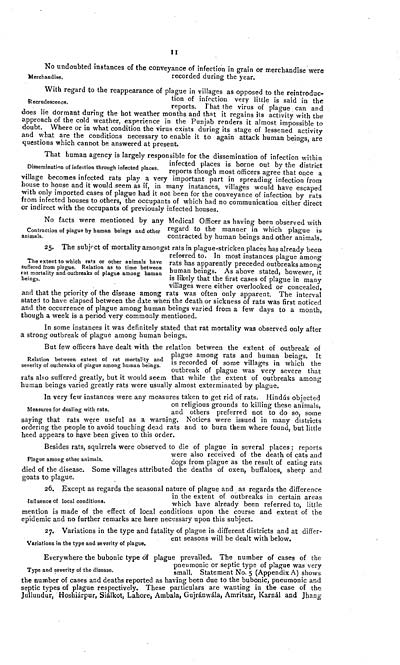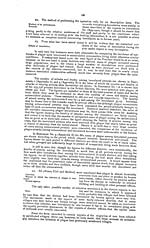Medicine - Disease > Report on plague in the Punjab from October 1st ... to September 30th ..., being the ... season of plague in the province
(25) Page 11
Download files
Individual page:
Thumbnail gallery: Grid view | List view

II
Merchandise.
No undoubted instances of the conveyance of infection in grain or merchandise were
recorded during the year.
Recrudescence.
With regard to the reappearance of plague in villages as opposed to the reintroduc-
tion of infection very little is said in the
reports. That the virus of plague can and
does lie dormant during the hot weather months and that it regains its activity with the
approach of the cold weather, experience in the Punjab renders it almost impossible to
doubt. Where or in what condition the virus exists during its stage of lessened activity
and what are the conditions necessary to enable it to again attack human beings, are
questions which cannot be answered at present.
Dissemination of infection through infected places.
That human agency is largely responsible for the dissemination of infection within
infected places is borne out by the district
reports though most officers agree that once a
village becomes infected rats play a very important part in spreading infection from
house to house and it would seem as if, in many instances, villages would have escaped
with only imported cases of plague had it not been for the conveyance of infection by rats
from infected houses to others, the occupants of which had no communication either direct
or indirect with the occupants of previously infected houses.
Contraction of plague by human beings and other
animals.
No facts were mentioned by any Medical Officer as having been observed with
regard to the manner in which plague is
contracted by human beings and other animals.
The extent to which rats or other animals have
suffered from plague. Relation as to time between
rat mortality and outbreaks of plague among human
beings.
25. The subject of mortality amongst rats in plague-stricken places has already been
referred to. In most instances plague among
rats has apparently preceded outbreaks among
human beings. As above stated, however, it
is likely that the first cases of plague m many
villages were either overlooked or concealed,
and that the priority of the disease among rats was often only apparent. The interval
stated to have elapsed between the date when the death or sickness of rats was first noticed
and the occurrence of plague among human beings varied from a few days to a month,
though a week is a period very commonly mentioned.
In some instances it was definitely stated that rat mortality was observed only after
a strong outbreak of plague among human beings.
Relation between extent of rat mortality and
severity of outbreaks of plague among human beings.
But few officers have dealt with the relation between the extent of outbreak of
plague among rats and human beings. It
is recorded Of some villages in which the
of outbreaks of plague among human beings.
outbreak or plague was very severe that
rats also suffered greatly, but it would seem that while the extent of outbreaks among
human beings varied greatly rats were usually almost exterminated by plague.
Measures for dealing with rats.
In very few instances were any measures taken to get rid of rats. Hindus objected
on religious grounds to killing these animals,
and others preferred not to do so, some
saying that rats were useful as a warning. Notices were issued in many districts
ordering the people to avoid touching dead rats and to burn them where found, but little
heed appears to have been given to this order.
Plague among other animals.
Besides rats, squirrels were observed to die of plague in several places ; reports
were also received of the death of cats and
dogs from plague as the result of eating rats
died of the disease. Some villages attributed the deaths of oxen, buffaloes, sheep and
goats to plague.
Influence of local conditions,
26. Except as regards the seasonal nature of plague and as regards the difference
in the extent of outbreaks in certain areas
which have already been referred to, little
mention is made of the effect of local conditions upon the course and extent of the
epidemic and no further remarks are here necessary upon this subject.
Variations in the type and seventy of plague.
27. Variations in the type and fatality of plague in different districts and at differ-
ent seasons will be dealt with below.
Type and severity of the disease.
Everywhere the bubonic type of plague prevailed. The number of cases of the
pneumonic or septic type of plague was very
small. Statement No. 5 (Appendix A) shows
the number of cases and deaths reported as having been due to the bubonic, pneumonic and
septic types of plague respectively. These particulars are wanting in the case of the
Jullundur, Hoshirpur, Silkot, Lahore, Ambala, Gujrnwla, Amritsar, Karnl and Jhang
Merchandise.
No undoubted instances of the conveyance of infection in grain or merchandise were
recorded during the year.
Recrudescence.
With regard to the reappearance of plague in villages as opposed to the reintroduc-
tion of infection very little is said in the
reports. That the virus of plague can and
does lie dormant during the hot weather months and that it regains its activity with the
approach of the cold weather, experience in the Punjab renders it almost impossible to
doubt. Where or in what condition the virus exists during its stage of lessened activity
and what are the conditions necessary to enable it to again attack human beings, are
questions which cannot be answered at present.
Dissemination of infection through infected places.
That human agency is largely responsible for the dissemination of infection within
infected places is borne out by the district
reports though most officers agree that once a
village becomes infected rats play a very important part in spreading infection from
house to house and it would seem as if, in many instances, villages would have escaped
with only imported cases of plague had it not been for the conveyance of infection by rats
from infected houses to others, the occupants of which had no communication either direct
or indirect with the occupants of previously infected houses.
Contraction of plague by human beings and other
animals.
No facts were mentioned by any Medical Officer as having been observed with
regard to the manner in which plague is
contracted by human beings and other animals.
The extent to which rats or other animals have
suffered from plague. Relation as to time between
rat mortality and outbreaks of plague among human
beings.
25. The subject of mortality amongst rats in plague-stricken places has already been
referred to. In most instances plague among
rats has apparently preceded outbreaks among
human beings. As above stated, however, it
is likely that the first cases of plague m many
villages were either overlooked or concealed,
and that the priority of the disease among rats was often only apparent. The interval
stated to have elapsed between the date when the death or sickness of rats was first noticed
and the occurrence of plague among human beings varied from a few days to a month,
though a week is a period very commonly mentioned.
In some instances it was definitely stated that rat mortality was observed only after
a strong outbreak of plague among human beings.
Relation between extent of rat mortality and
severity of outbreaks of plague among human beings.
But few officers have dealt with the relation between the extent of outbreak of
plague among rats and human beings. It
is recorded Of some villages in which the
of outbreaks of plague among human beings.
outbreak or plague was very severe that
rats also suffered greatly, but it would seem that while the extent of outbreaks among
human beings varied greatly rats were usually almost exterminated by plague.
Measures for dealing with rats.
In very few instances were any measures taken to get rid of rats. Hindus objected
on religious grounds to killing these animals,
and others preferred not to do so, some
saying that rats were useful as a warning. Notices were issued in many districts
ordering the people to avoid touching dead rats and to burn them where found, but little
heed appears to have been given to this order.
Plague among other animals.
Besides rats, squirrels were observed to die of plague in several places ; reports
were also received of the death of cats and
dogs from plague as the result of eating rats
died of the disease. Some villages attributed the deaths of oxen, buffaloes, sheep and
goats to plague.
Influence of local conditions,
26. Except as regards the seasonal nature of plague and as regards the difference
in the extent of outbreaks in certain areas
which have already been referred to, little
mention is made of the effect of local conditions upon the course and extent of the
epidemic and no further remarks are here necessary upon this subject.
Variations in the type and seventy of plague.
27. Variations in the type and fatality of plague in different districts and at differ-
ent seasons will be dealt with below.
Type and severity of the disease.
Everywhere the bubonic type of plague prevailed. The number of cases of the
pneumonic or septic type of plague was very
small. Statement No. 5 (Appendix A) shows
the number of cases and deaths reported as having been due to the bubonic, pneumonic and
septic types of plague respectively. These particulars are wanting in the case of the
Jullundur, Hoshirpur, Silkot, Lahore, Ambala, Gujrnwla, Amritsar, Karnl and Jhang
Set display mode to: Large image | Zoom image | Transcription
Images and transcriptions on this page, including medium image downloads, may be used under the Creative Commons Attribution 4.0 International Licence unless otherwise stated. ![]()
| India Papers > Medicine - Disease > Report on plague in the Punjab from October 1st ... to September 30th ..., being the ... season of plague in the province > (25) Page 11 |
|---|
| Permanent URL | https://digital.nls.uk/74579354 |
|---|




